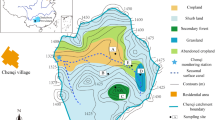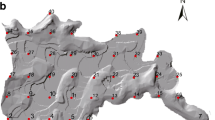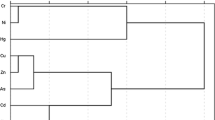Abstract
This study investigated the distribution of six pollutant elements (Cr, Cu, Pb, Zn, Cd, and As), and their relationship to soil organic carbon (SOC) in five soil profiles in the Puding area. Results show SOC content decreased exponentially to the depth of soil profiles; the vertical distribution patterns of SOC in soil profiles were partially controlled by land use. The concentrations of these pollutant elements in most soils were lower than background values, indicating that the local soil was less likely to be contaminated by foreign inputs. Geo-accumulation index values of these elements in most soil samples were less than 1, suggesting that the soil of this area may not be polluted. The concentrations of Cr, Cu, As, and Zn in soils from all land use types were significantly negatively correlated with SOC contents. Geochemical approaches confirmed that the soil of this area was less influenced by pollutant elements.
Similar content being viewed by others
Explore related subjects
Discover the latest articles, news and stories from top researchers in related subjects.Avoid common mistakes on your manuscript.
1 Introduction
Anthropogenic heavy metal contamination in soil environments is a globally important issue (Acosta et al. 2011). Agricultural fertilization causes enrichment of some heavy metals, such as Zn, Cu, and Cd (Nicholson et al. 2003). Among numerous soil pollutants, heavy metals (Cd, Cu, Pb, Zn, Cr, and As; though Arsenic is not a heavy metal, it shares many toxic characteristics with heavy metals and undergoes similar environmental processes) are especially dangerous due to their toxicity (Facchinelli et al. 2001; Staszewski et al. 2012). The distribution of heavy metals under different land management has been widely explored (Oleszek et al. 2003; Qishlaqi et al. 2009).
Karst ecosystems are highly fragile environments that suffer from progressive degradation (Parise et al. 2009). Soil degradation is a serious ecological problem in the subtropical karst regions of Southwest China (Yuan 1997). Variable land use and land cover create an environmental gradient of soil organic carbon (SOC) content that reflects the effects of soil organic matter (SOM) on vertical transporting processes of heavy metals (Han et al. 2015; Zeng et al. 2011). This study explored the distribution patterns of SOC, Cr, Cu, Pb, Zn, As, and Cd in soil profiles under different land use types in a karst catchment in Puding, Southwest China. Geochemical approaches such as correlation analysis, principal component analysis, and geo-accumulation index were used to explore the relationship between heavy metals and soil properties (pH and SOM) (Pardo et al. 2013; Qishlaqi et al. 2009).
2 Materials and methods
2.1 Study area
Puding is a typical karst area located in the west of Guizhou Province, southwestern China (Fig. 1), at longitude 105°46.201′E to 105° 47.038′E, latitude 26°15.079′N to 26°16.238′N, and with an altitude of 1042–1846 m. The area is controlled by a warm-humid subtropical monsoon climate; the mean annual precipitation is approximately 1400 mm and the mean annual temperature is 15.1 °C (Wu et al. 2012). Puding is dominated by Permian and Triassic carbonate rocks with highly fragile environments. Karst rocky desertification areas account for 21.5% of the Puding jurisdiction.
2.2 Sampling and analysis method
The sampling sites were chosen under different land uses for a small enclosed karst basin in 2012 (Fig. 1). The five soil profiles sampled were in a virgin forested site (ZJT), a secondary forest (DJS), shrubbery (YPG), grassland (CQC), and farmland (YMD). Forty-six soil samples were collected at intervals of 10 cm to the boundary of rock and soil at each site. Soil samples were air-dried, ground into powder, and sieved (mesh size: 75 μm). After removal of carbonates with 6 mol/L HCl, SOC content was analyzed by an elemental analyzer (PE2400, Perkin Elmer, USA). Soil pH was determined with a soil and distilled water ratio of 1:2.5. Similar digesting methods (Roy and Smykatz-Kloss 2007; Tang and Han 2015) were used to digest the soil sample powder; heavy metal concentrations (Cd, Cu, Pb, Zn, Cr, and As) were tested by an Agilent 7500a ICP-MS at Institute of Geochemistry, Chinese Academy of Sciences.
3 Results and discussion
3.1 Basic statistics of heavy element contents
Most of the soils were slightly alkaline with pH in the range of 6.0–7.9. SOC content ranged from 0.48% to 7.92%, and decreased exponentially to the depth of soil profiles. This trend appears to be consistent with previous reports on the soils of Guizhou Province (Han et al. 2015). In different land use sites, the SOC of YPG (shrub) and CQC (grassland) was significantly higher and more variable with depth than that in forest (ZJT, DJS) and farmland (YMD), due to high C4 plant input. Due to harvesting, profile YMD showed the lowest SOC concentrations.
The heavy metal contents of soil samples varied. The mean concentrations of Cr and Cd were 66.3–80.0 mg·kg−1 and 0.18–0.30 mg·kg−1, respectively, across all five profiles, both lower than background values (BV) of Guizhou Soil (CEMS 1990). Zn was lower than BV except in ZJT, while the mean concentrations of As (21.2–36.0 mg·kg−1) were higher than BV. The mean concentrations of Cu and Pb were close to BV, thus the soil of Puding may not be contaminated by heavy metals. The mean concentrations of Cr, Cu, and Pb in YMD were higher than those in other profiles, and the mean concentrations of Zn and As in ZJT were higher than those of other profiles. The concentrations of some heavy metals had similar distribution trends across the different soil profiles: concentrations of Cr, Cu, Zn, and As generally increased with soil depth, while concentrations of Pb and Cd decreased with depth (Fig. 2). The different distribution patterns of heavy metals in soil indicate that the sources and migration characteristics of these two groups were different.
3.2 Correlation analysis
Correlation between heavy metals in soils can provide some information on the sources and pathways (Rodriguez et al. 2008). Positive correlations between Cr and Cu and As, SOC and Cd, and Pb and Zn clearly reflect that these elements have the same sources in Puding soils. There was a negative relationship between SOC and Cu, and between SOC and Cr, indicating that the spatial distribution of the heavy metals is influenced by organic matter input; the input of SOC might “dilute” the content of heavy metals in the soil. The correlation between pH values and heavy metal concentrations was not significant in most soil profiles. This might be due to the minimal variation of soil pH values The correlations between heavy metals were generally stronger in ZJT and DJS than in other soil profiles.
3.3 Geo-accumulation index
The geo-accumulation index (I geo) introduced by Muller (Muller 1969) was used to assess metal pollution. I geo for soil samples was calculated as I geo = log (Cn/1.5Bn)2 , where Cn is the measured concentration of a given element in the soil, Bn is the geochemical background value of this element, and 1.5 is the factor used for lithological variations of trace metals.
Results of I geo calculated for the heavy metal of soils returned values for As > Cu > Pb > Cd ≈ Cu > Zn. The I geo values of the six heavy metals in most soil samples were less than 0, except for As (Fig. 3), suggesting that the soil of this area may not be artificially polluted by heavy metals. Though the two forest soil profiles (ZJT and DJS) showed slight accumulation of As at all depths, I geo values of As were greater than 0 but less than 1, indicating that the local soil may not be polluted by arsenic; rather, there may be weathering of some arsenic-rich minerals in bedrock. The I geo values in farmland soils (YMD) were similar across depths, indicating that cultivation has promoted the migration of heavy metals at different soil depths.
4 Conclusions
A database for heavy metals (Cr, Cu, As, Pb, Zn, Cd) in different soils of Puding County has been created. SOC content decreased exponentially with depth; land use patterns and dominant species types had significant effects on the vertical distribution of SOC in soil profiles. Heavy metal contents in most soils were lower than BV, indicating that the local soil was unlikely to have been contaminated by foreign inputs.
The distribution patterns of heavy metals in soil showed that the source and migration characteristics were different, and were related to SOC content and to the physical characteristics of soil profiles. I geo values of heavy metals in most soil samples were less than 1, suggesting that the soil of this area may not be polluted, and that heavy metals present were more likely from the weathering of local bedrock. I geo values in farmland soils were invariable with depth, suggesting that thorough cultivation has promoted the migration of heavy metals in soil layers.
References
Acosta JA, Faz A, Martinez M et al (2011) Multivariate statistical and GIS-based approach to evaluate heavy metals behavior in mine sites for future reclamation. J Geochem Explor 109(1–3):8–17
Chinese Environmental Monitoring Station (CEMS) (1990) Element background values of China’s soil. Chinese Environmental Science Press, Beijing
Facchinelli A, Sacchi E, Mallen L (2001) Multivariate statistical and GIS-based approach to identify heavy metal sources in soils. Environ Pollut 114(3):313–324
Han G, Li F, Tang Y (2015) Variations in soil organic carbon contents and isotopic compositions under different land uses in a typical karst area in Southwest China. Geochem J 49(1):63–71
Muller G (1969) Index of geoaccumulation in sediments of the Rhine River. Geochem J 2:108–118
Nicholson FA, Smith SR, Alloway BJ et al (2003) An inventory of heavy metals inputs to agricultural soils in England and Wales. Sci Total Environ 311(1–3):205–219
Oleszek W, Terelak H, Maliszewska-Kordybach B et al (2003) Soil, food and agroproduct contamination monitoring in Poland. Pol J Environ Stud 12(3):261–268
Pardo R, Vega M, Barrado E et al (2013) Three-way principal component analysis as a tool to evaluate the chemical stability of metal bearing residues from wastewater treatment by the ferrite process. J Hazard Mater 262:71–82
Parise M, De Waele J, Gutierrez F (2009) Current perspectives on the environmental impacts and hazards in karst. Environ Geol 58(2):235–237
Qishlaqi A, Moore F, Forghani G (2009) Characterization of metal pollution in soils under two landuse patterns in the Angouran region, NW Iran; a study based on multivariate data analysis. J Hazard Mater 172(1):374–384
Rodriguez JA, Nanos N, Grau JM et al (2008) Multiscale analysis of heavy metal contents in Spanish agricultural topsoils. Chemosphere 70(6):1085–1096
Roy PD, Smykatz-Kloss W (2007) REE geochemistry of the recent playa sediments from the Thar Desert, India: an implication to playa sediment provenance. Chemie Der Erde-Geochemistry 67(1):55–68
Staszewski T, Lukasik W, Kubiesa P (2012) Contamination of Polish national parks with heavy metals. Environ Monit Assess 184(7):4597–4608
Tang Y, Han G (2015) Characteristics of major elements and heavy metals in atmospheric dust in Beijing, China. J Geochem Explor. doi:10.1016/j.gexplo.2015.12.002
Wu Q, Han G, Tao F et al (2012) Chemical composition of rainwater in a karstic agricultural area, Southwest China: the impact of urbanization. Atmos Res 111:71–78
Yuan DX (1997) Sensitivity of karst process to environmental change along the Pep II transect. Quatern Int 37:105–113
Zeng F, Ali S, Zhang H et al (2011) The influence of pH and organic matter content in paddy soil on heavy metal availability and their uptake by rice plants. Environ Pollut 159(1):84–91
Acknowledgements
This work was jointly supported by the National Natural Science Foundation of China (Grant Nos. 41325010; 41403109), National Key Basic Research Program of China (Grant No. 2013CB956703).
Author information
Authors and Affiliations
Corresponding author
Additional information
11th International Symposium on Geochemistry of the Earth’s Surface.
Rights and permissions
About this article
Cite this article
Tang, Y., Han, G. Characteristics of heavy metals in soils under different land use in a typical karst area, Southwest China. Acta Geochim 36, 515–518 (2017). https://doi.org/10.1007/s11631-017-0223-x
Received:
Revised:
Accepted:
Published:
Issue Date:
DOI: https://doi.org/10.1007/s11631-017-0223-x







